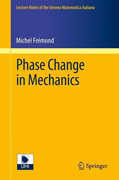
Predictive theories of phenomena involving phase change with applications in engineering are investigated in this volume, e.g. solid-liquid phase change, volume and surface damage, and phase change involving temperature discontinuities. Many other phase change phenomena such as solid-solid phase change in shape memory alloys and vapor-liquid phase change are also explored. Modeling is based on continuum thermo-mechanics. This involves a renewed principle of virtual power introducing the power of the microscopic motions responsible for phase change. This improvement yields a new equation of motion related to microscopic motions, beyond the classical equation of motion for macroscopic motions. The new theory sensibly improves the phase change modeling. For example, when warm rain falls on frozen soil, the dangerous black ice phenomenon can be comprehensively predicted. In addition, novel equations predict the evolution of clouds, which are themselves a mixture of air, liquid water and vapor. Thermomechanical predictive theories of phase change are improved by a renewed principle of virtual power. Coupling of volume damage and of surface adhesion are highly innovative for civil and mechanical engineering. A novel theory of macroscopic clouds evolution innovates in fluid mechanics. Mechanical andthermal effects of collisions, involving phase change are accurately and comprehensively predicted. INDICE: 1 Introduction. 2 The State Quantities and the Quantities Describing the Evolution. 3 The Basic Laws of Mechanics. 4 Solid-liquid Phase Change. 5 Shape Memory Alloys. 6 Damage. 7 Contact with Adhesion. 8 Damage of Solids Glued on One Another. Coupling of Volume and Surface Damages. 9 Phase Change with Discontinuity of Temperature: Warm Water in Contact with Cold Ice. 10 PhaseChange and Collisions. 11 Collisions of Deformable Bodies and Phase Change. 12 Phase Change Depending on a State Quantity: Liquid-vapor Phase Change. 13 Clouds: Mixture of Air, Vapor and Liquid Water. 14 Conclusion.
- ISBN: 978-3-642-24608-1
- Editorial: Springer Berlin Heidelberg
- Encuadernacion: Rústica
- Páginas: 292
- Fecha Publicación: 31/12/2011
- Nº Volúmenes: 1
- Idioma: Inglés
